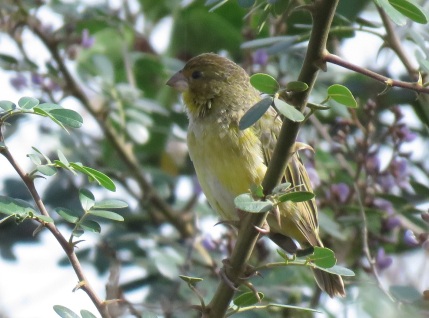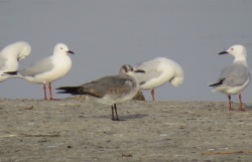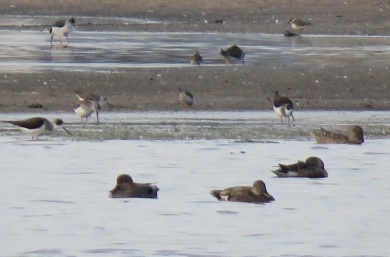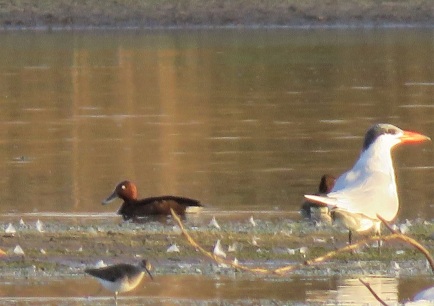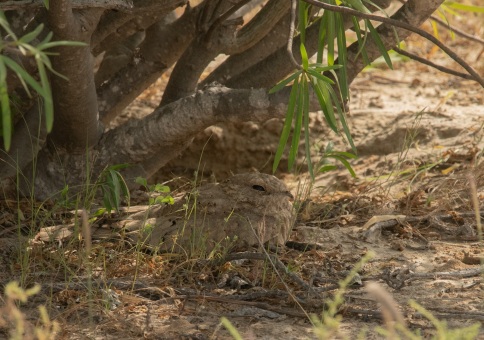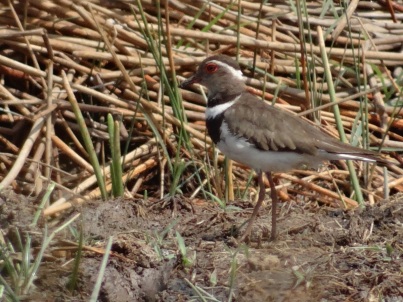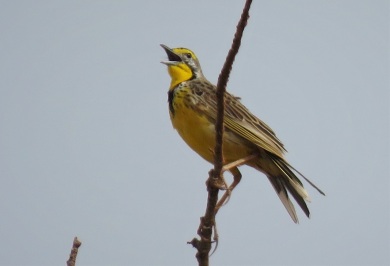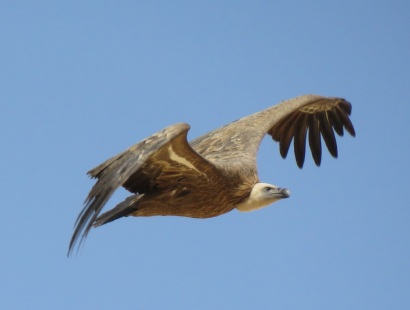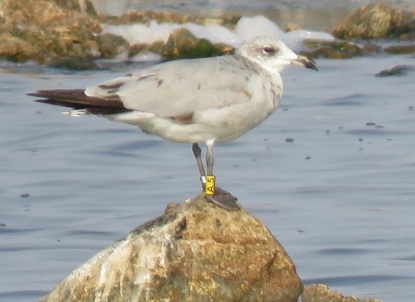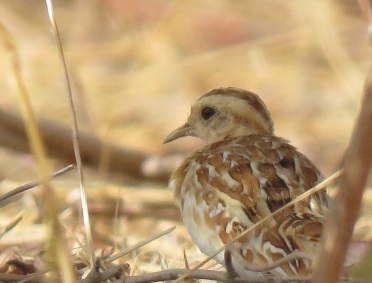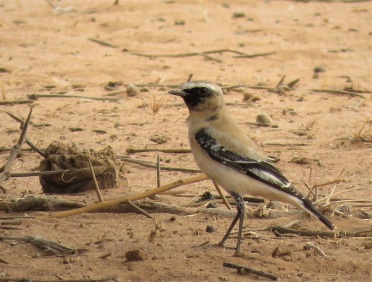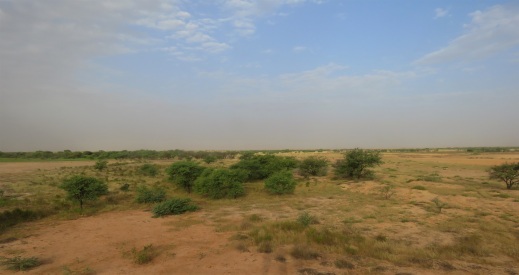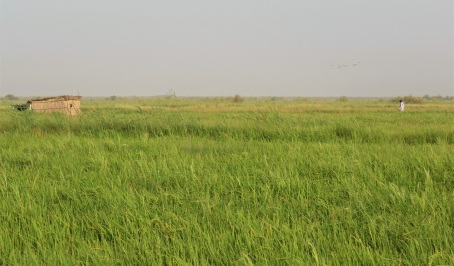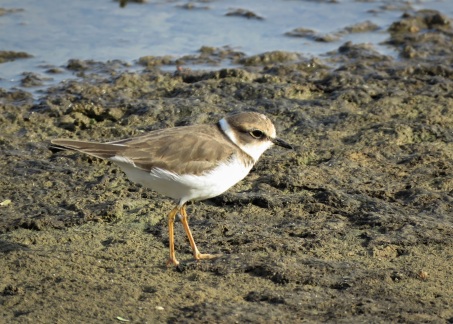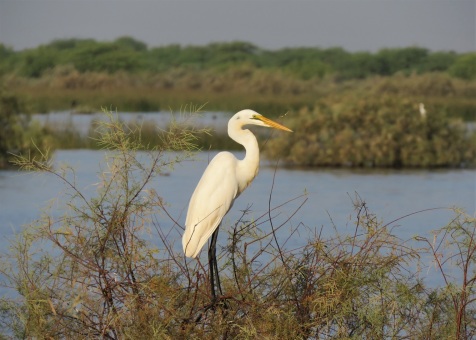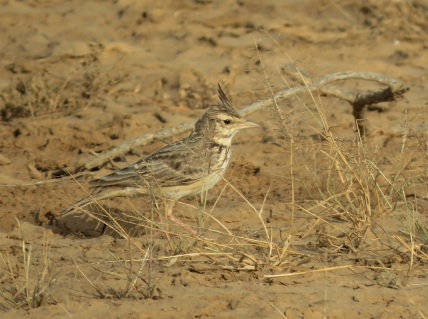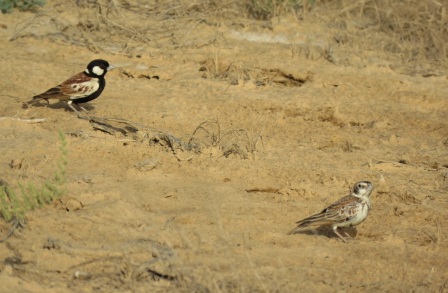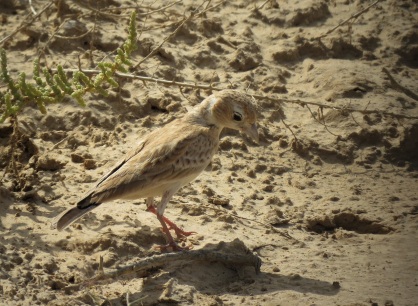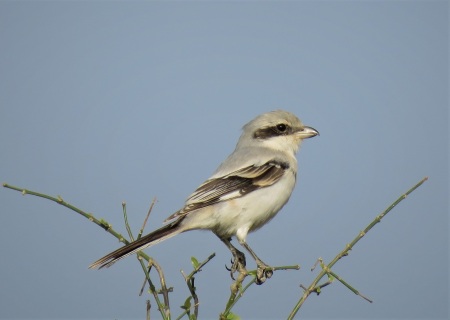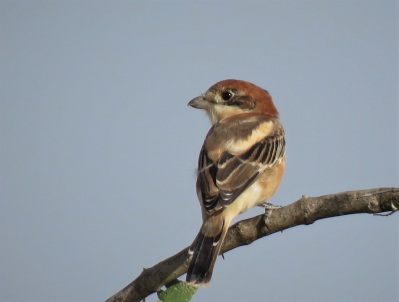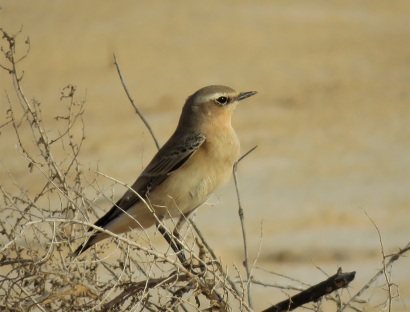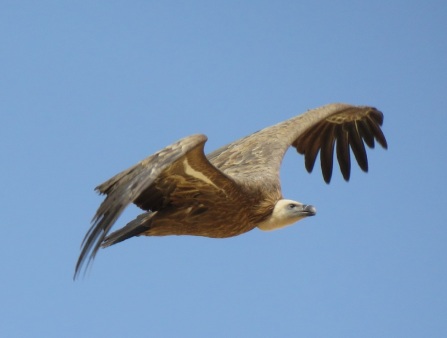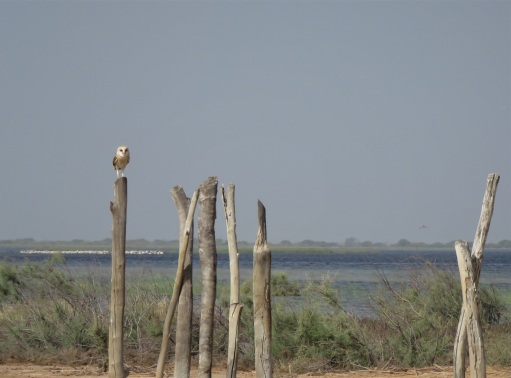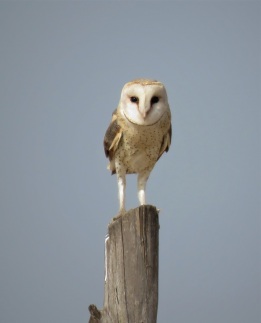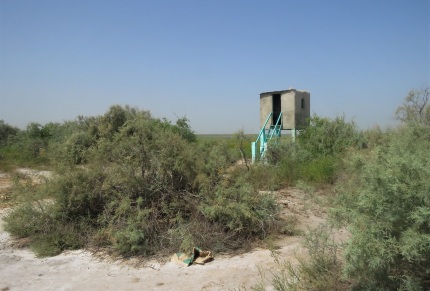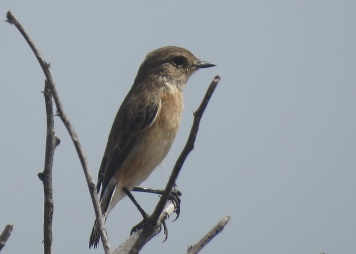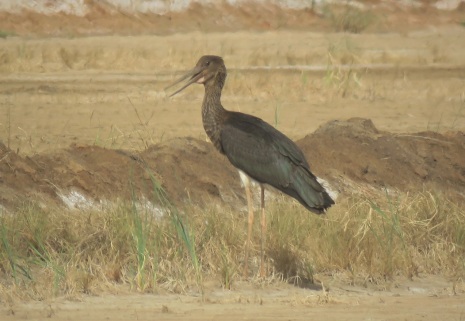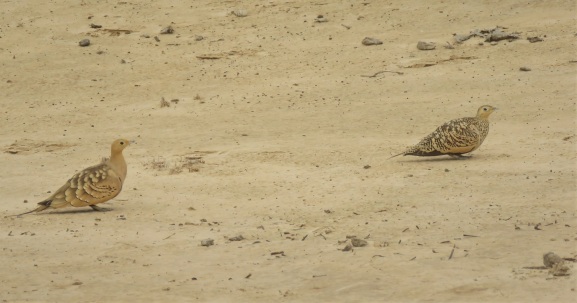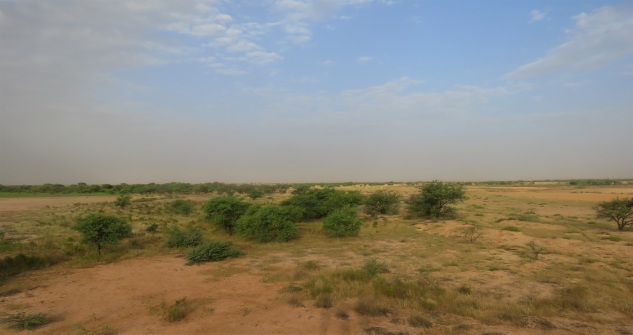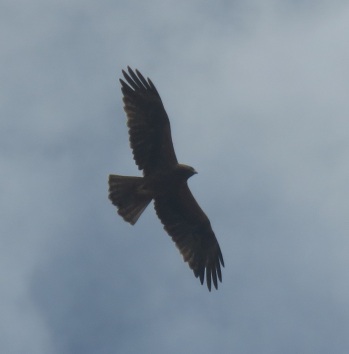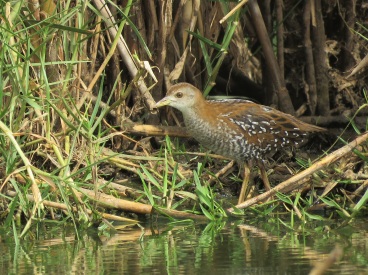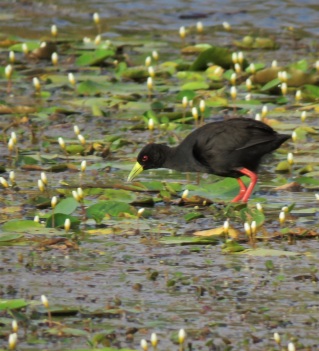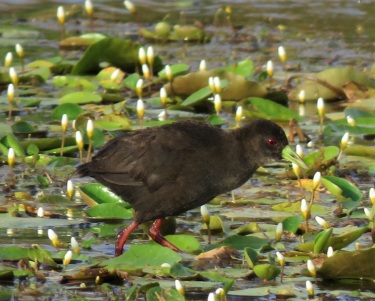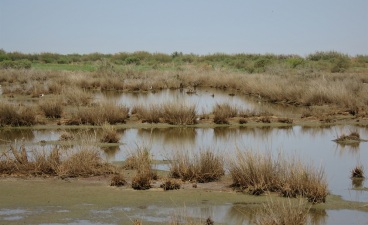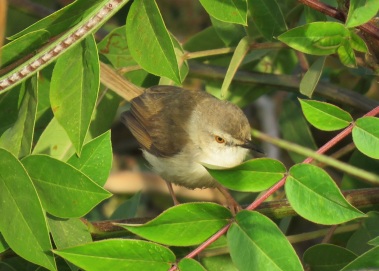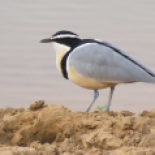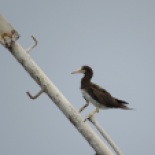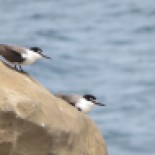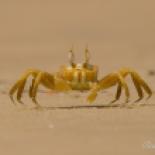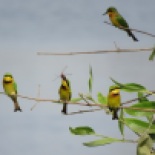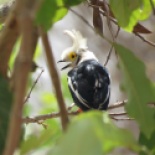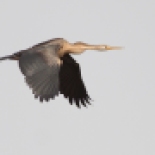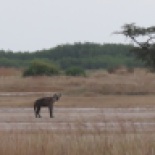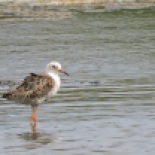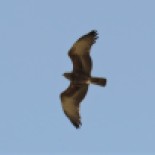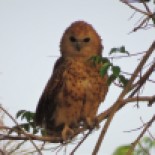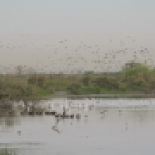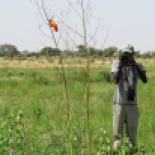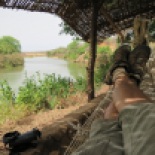Year in review: 2019
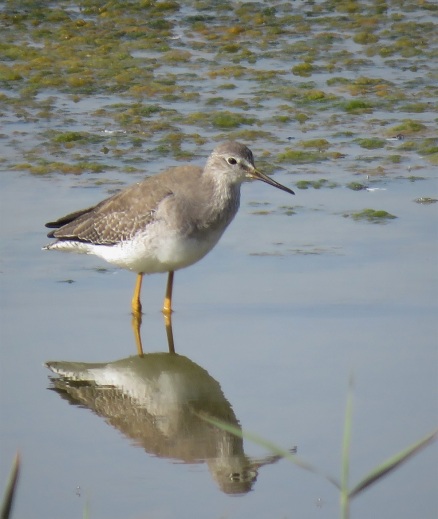
As is now a bit of a tradition on these pages, I’m again compiling a review of last year’s main birding events. Senegal’s bird year 2019 was a pretty good one, with the usual decent mix of new discoveries, rare vagrants, scarce migrants, range extensions and new breeding records.
First things first: last year saw the addition of two new species to the country’s avifauna, so rather similar to previous years – on average, there have been two additions per year during 2014-2018. First a Willcock’s Honeyguide in Dindefelo nature reserve found by Nik Borrow and his group in January, then the discovery of a small group of Cuckoo Finches at Kagnout in Casamance, in February by Bruno Bargain, Gabriel Caucal and Adrien de Montaudouin. As predicted back in 2018, both Dindefelo and Casamance are obviously key areas for finding new birds in the country. Both species are known to occur in neighbouring countries so these additions are not too much of a surprise, and will likely show up again in Senegal in coming years. These “firsts” bring the total number of species confirmed to occur in Senegal to 674, with seven additional species listed as requiring confirmation. The full checklist as per IOC taxonomy (v.8.1) may be found here.
Next up, the usual lot of vagrants: from North America, the now annual American Golden Plovers (Palmarin in April, and Yene in December), the country’s fourth Pectoral Sandpiper at Lac Mbeubeusse on 5.10, and a Lesser Yellowlegs wintering at Technopole – apparently the longest stay recorded in Africa (at least 71 days!), and most likely the same bird seen several years in a row now. Two Laughing Gulls that were present at Technopole in April-May – an adult in breeding plumage and a first-summer bird – were the 6th and 7th records; the immature was also seen at Ngor on 22.5. Also at Technopole were at least two different Franklin’s Gulls, one in January and two in April-May including an adult displaying to other gulls. A Lesser Jacana was found by Vieux Ngom on 16.3 on the Lampsar, while a Spotted Creeper on 17.12 at Kamobeul (Ziguinchor) was another rarely recorded Afro-tropical vagrant. And finally from Europe, a Little Gull – possibly not a true vagrant but rather a very scarce winter visitor – was seen on 8.3 at Ngor, and a European Golden Plover was at Saloulou island (Casamance) on 25.2.
Scarce migrants included a few species of ducks that are rarely reported from Senegal, starting with these three Gadwalls found by Simon Cavaillès at Technopole in January, which were probably the same birds as those seen in December 2018 in The Gambia. A Eurasian Wigeon was present at the same time; while the latter is regular in the Djoudj, both ducks were apparently seen for the first time in the Dakar region.
Almost a year later this pair of Ferruginous Ducks on a small dam at Pointe Sarène near Mbour on 24.12 were a real surprise in this location. Apparently they didn’t stick around: earlier today (19.1.20) I had the chance to visit the dam again but no sign of our two Palearctic ducks…
An African Crake found by Miguel Lecoq in a dry river bed at Popenguine NR on 12.7 was highly unusual. The two Short-eared Owls at Technopole in January (with one still here on 11.2) were possibly returning birds from the 2017-18 influx as they roosted in exactly the same location; another bird was found in the Djoudj on 26.12 by Vieux and Frank Rheindt. Perhaps more unexpected was a Marsh Owl that was actively migrating at Ngor on 8.10, coming from the north out at sea, but even more spectacular was the discovery of an Egyptian Nightjar by Frédéric Bacuez on his local patch at Trois-Marigots, on 23.10 (an early date and first in this location); in the Djoudj NP, a somewhat classic location for the species, three birds were seen several times from 23.11 up to mid December at least.
A few Red-footed Boobies were again seen at Ngor: an adult on 3.7 and likely the same bird again on 22.7, then daily from 9-12.8 (with two here on 17.8), and again an imm. seen twice in November. These are the 5th to 7th records, a remarkable presence given that the first record was in October 2016 only! As usual, several Brown Boobies were seen as well but we didn’t get the chance to properly check on the birds at Iles de la Madeleine this past year. Other scarce seabirds seen from Ngor were a Balearic Shearwater (18.11), a Bulwer’s Petrel (5.12), several Leach’s Storm-Petrels (11 & 13.11), and some 30 Barolo’s/Boyd’s Shearwaters that passed through in August and September. A Baltic Gull (fuscus Lesser Black-backed Gull) at Technopole 27.1 was our first record here.
Quite a few birds were reported for the first time from Casamance by Bruno and friends, and several resident forest species that had not been seen in many years were “rediscovered” this past year, such as Black-shouldered Nightjar, Black Sparrowhawk, White-throated and Slender-billed Greenbuls, Flappet Lark, Red-faced and Dorst’s Cisticolas – the online Casamance atlast can be found here. Several Senegal Lapwings were again seen towards the end of the rains, and a Forbes’s Plover at Kagnout on 17.2 was definitely a good record as the species had previously been reported only on a few occasions from the Niokolo-Koba NP.
A Brown-throated (= Plain) Martin feeding over the lagoon at Technopole on 28.4 was a first for Dakar; this species is rarely seen in Senegal it seems. A few Moltoni’s Warblers were reported in autumn including at least one on 20.10 at Mboro, where Miguel also noted several northward range extensions such as Fine-spotted Woodpecker, Grey Kestrel, Splendid Sunbird, and Orange-cheeked Waxbill. The observation of two Mottled Spinetails some 15km south of Potou (Louga region) is the northernmost so far and seems to confirm the presence in this part of the country, following one in the same region in January 2018. A pair of Little Grey Woodpeckers at Lompoul and the discovery of Cricket Warbler in the Gossas area (Diourbel) are also noteworthy as they are just outside known distribution ranges for these two Sahelian species. More significant is the observation of a Long-billed Pipit on the Dande plateau near Dindefelo on 9.2, as this is the first record away from the Djoudj area, raising the possibility that the species is breeding in the vicinity.
Additional good records for the Dakar region included a White-throated Bee-eater on 12.8, a Red-breasted Swallow near Diamniadio on 11.10 and Grasshopper Warblers at Yene lagoon on 8 & 15.12, as well as at Lac Tanma (Thiès region) on 27.10 – and more surprisingly, one was found aboard a sail boat some “400 Miles South West Of Dakar” on 13.9. Last year we documented oversummering of Yellow-legged and Mediterranean Gulls on the peninsula.
We also continued our modest efforts to survey breeding Black-winged Stilts at several sites in Dakar, Ziguinchor and Saint-Louis; the findings of these should be formally published later this year. The Horus Swift colony was visited on several occasions (Jan.-March and Nov.-Dec.) with further evidence of breeding. A pair of Tawny Eagles at their nest site on a high tension pylon near Ndioum, where they are known since at least 2015, were seen again in December by Frédéric and Jérémy. Yellow-throated Longclaw was found to be breeding at lac Mbeubeusse and probably at lac Rose as well: more on the species in this post.
In July we found several additional pairs of Turati’s Boubou right on the border with Guinea-Bissau, a bit further to the south of the site where Bruno initially found the species, in October 2018 near Ziguinchor. Also in Casamance, breeding was confirmed for Common Buttonquail, Golden-tailed Woodpecker, and a whole range of other species.
Another noteworthy record is that of a group of 113 Eurasian Griffons in the Djoudj NP on 2.11 – apparently the largest flock ever recorded in Senegal! This surely reflects the general increase in numbers of what used to be a rather scarce species it seems – read up more on the status of this vulture in Senegal in this post on Ornithondar.
As usual, a few interesting ring recoveries were obtained, including several returning birds, providing further evidence for site fidelity and local movements between key sites for e.g. Black-tailed Godwits and Ospreys of course, but also for a Eurasian Spoonbill from Spain – more on this in a future post. A Gull-billed Tern from the Neufelderkoog colony in northern Germany was also a good recovery, just like the many Sandwich Terns that we managed to read at Technopole in April-May with birds originating from Ireland, the UK, the Netherlands and Italy! Also of note were a French Black-headed Gull, the first colour-ringed Greenshank and wing-tagged Marsh Harrier in our ever-growing database, and last but not least the first recovery of a Croatian-ringed bird in Senegal, an Audouin’s Gull seen at three sites in Dakar in January and February.
During 2019 I was fortunate to continue our regular coverage of Technopole but also for the third consecutive year of seabird migration at Ngor, and managed a few trips further afield: the northern Saloum delta (Simal, Palmarin), three trips to Casamance (January, May, July), the Petite Côte (at long last explored the lagoons at Mbodiene!), the Langue de Barbarie and Trois-Marigots in April, the Djoudj and other parts of the lower Senegal valley (November), and finally Toubacouta in December. Oh and a memorable day trip on a successful quest for the enigmatic Quail-Plover!
Other blog posts this past year covered the status and distribution (and a bit of identification!) of Seebohm’s Wheatear, Iberian Chiffchaff, and Western Square-tailed Drongo.
Another series focused on recent ornithological publications relevant for Senegal, in three parts. I’m not sure how I managed but in the end I was involved in quite a few articles published in 2019: the autumn migration of seabirds at Ngor and the status of Iberian Chiffchaff in West Africa (the latter with Paul Isenmann and Stuart Sharp) in Alauda, the first records of Eurasian Collared Dove and of Turati’s Boubou in Senegal (the latter with Bruno Bargain) published in Malimbus, and finally two papers in the Bulletin of the African Bird Club: a short piece on the hybrid shrike from lac Tanma in 2017 (with Gabriel Caucanas), and a review of the status of the Short-eared Owl in West Africa, following the influx during winter 2017/18.
Many thanks to all visiting and (semi-)resident birders who shared their observations through eBird or other channels, particularly Miguel, Frédéric and Bruno. The above review is of course incomplete and probably a bit biased towards the Dakar region: any additions are more than welcome and will be incorporated!
Petite revue de la bibliographie ornithologique sénégalaise, 2016-2019 (Première partie)
Divers articles consacrés à l’avifaune sénégalaise ont été publiés ces dernières années, nous incitant à faire une petite synthèse de ces publications. Le Sénégal est depuis une cinquantaine d’années une terre fertile pour les études ornithologiques, et ces dernières années cela n’a pas changé. Peut-être bien au contraire, même s’il n’y a plus de vrais ornithologues tels que les Morel ou Baillon résidant au pays – peut-être qu’un jour on se risquera à une note sur les nombreux chercheurs et autres personnages ayant marqué l’histoire ornithologique du pays. Peut-être.
Pour le moment, on se limitera aux 3-4 dernières années (2016-2019), en commençant par les publications ayant trait à l’écologie des espèces, suivi par quelques traités taxonomiques pertinents. La deuxième partie couvrira principalement les articles traitant du statut, de la phénologie et de la répartition d’espèces. J’en oublie certainement, donc tout complément que vous pourrez apporter sera grandement apprécié! Une partie des articles qui suivent sont déjà accessibles en ligne, p.ex. sur le site ResearchGate. Quelques-uns se trouvent sur notre page Ressources. Si nécessaire, je peux aussi fournir la plupart sur demande.
Seul bémol, l’absence quasi totale d’auteurs sénégalais dans les publications qui suivent… espérons que la relève ornitho locale – elle existe bel et bien, timidement – pourra changer cet état des lieux dans un futur proche. Ce triste constat a même été démontré, chiffres à l’appui, dans un article récent paru dans la revue Ostrich: Cresswell W. 2018. The continuing lack of ornithological research capacity in almost all of West Africa. Ostrich 89: 123–129. [Le manque continu de capacité de recherche ornithologique dans presque toute l’Afrique de l’Ouest]
Ecologie
- Comment les Busards cendrés font face au Paradoxe de Moreau pendant l’hiver sahélien: Schlaich et al. 2016. How individual Montagu’s Harriers cope with Moreau’s Paradox during the Sahelian winter. Journal of Animal Ecology (doi: 10.1111/1365-2656.12583).
Cette étude sur le Busard cendré, menée par une équipe franco-hollandaise, illustre de manière concrète comment un hivernant paléarctique répond au paradoxe de Moreau. Ce terme fait référence au phénomène des conditions écologiques se dégradant au fur et à mesure que la saison d’hivernage avance dans le Sahel alors que les migrateurs doivent se préparer pour leur migration prénuptiale bien que les conditions soient alors plus sévères. En suivant 36 busards hivernant au Sénégal, l’équipe a étudié leur utilisation de l’habitat et leur comportement tout en collectant des données sur l’abondance des criquets, leur principale source d’alimentation sur les quartiers d’hiver. Ils ont trouvé que la fin de la période d’hivernage pourrait constituer un goulot d’étranglement au cours du cycle annuel, avec des effets de report possibles sur la saison de reproduction. Les changements climatiques en cours avec moins de précipitations dans le Sahel, associés à une pression humaine accrue sur les habitats naturels et agricoles, entraînant dégradation et désertification, rendront probablement cette période plus exigeante, ce qui pourrait avoir un impact négatif sur les populations d’oiseaux hivernant dans le Sahel.
Le Busard cendré est l’une des rares espèces à être bien étudiée au Sénégal, notamment par des chercheurs de l’Université de Groningen (dont Almut Schlaich et Ben Koks) et du CNRS en France (V. Bretagnolle et cie.). La Barge à queue noire et dans une moindre mesure peut-être le Balbuzard pêcheur, deux autres espèces prioritaires pour la conservation en Europe de l’Ouest, sont également relativement bien suivies dans leurs quartiers d’hiver au Sénégal et régions limitrophes.
- Sélection de l’habitat, “home range” et taille de population de la Marouette de Baillon dans le delta du Sénégal: Seifert, Tegetmeyer & Schmitz-Ornés 2017. Habitat selection, home range and population size of Baillon’s Crake Zapornia pusilla in the Senegal Delta, north-west Senegal. Bird Conservation International (doi:10.1017/S0959270917000077).
Les trois chercheuses (équipe 100% féminine, fait assez rare pour le signaler !) se sont penchées sur une espèce très peu connue et difficile à étudier, en utilisant une approche multi-échelle pour évaluer les exigences en matière d’habitat de la Marouette de Baillon dans le delta du fleuve. Elles ont suivi par télémétrie 17 individus dans le PN des Oiseaux du Djoudj, puis ont modélisé à partir d’images satellitaires et des données de capture la probabilité de présence ainsi que la densité de la population. La taille du domaine vital de l’espèce mesure en moyenne 1,77 ± 0,86 ha, avec des différences significatives entre habitats. La Marouette de Baillon préfère au sein de ses habitats les structures de bord, comme les pistes battues, les bords des plans d’eau ouverts, ainsi que les limites d’une végétation spécifique. Basé sur les modèles de régression, 9’516 ha d’habitat favorable ont été identifiés dans la zone Djoudj, avec une taille de population potentielle de 10’714 ind. (3’146-17’408). Les zones humides du delta du fleuve ont donc une importance exceptionnelle pour les populations africaines et peut-être aussi européennes.
La même étude a également permis la publication, en 2015, d’un article sur le régime alimentaire de ce rallidé : Seiffert, Koschkar & Schmitz-Ornés 2015. Diet of Baillon‘s Crakes Zapornia pusilla: assessing differences in prey availability and consumption during the breeding season in the Senegal River Delta, West Africa. Acta Ornithologica 50: 69–84. [Régime alimentaire de la Marouette de Baillon : évaluation des différences en matière de disponibilité des proies et de consommation pendant la saison de reproduction dans le delta du fleuve Sénégal].
- Ecologie de l’alimentation de phaétons se reproduisant dans deux environnements marins contrastés de l’Atlantique tropical: Diop et al. 2018. Foraging ecology of tropicbirds breeding in two contrasting marine environments in the tropical Atlantic. Marine Ecology Progress Series 607: 221–236.
Menée par Ngone Diop, cette étude combine le suivi par GPS, des variables environnementales et des échantillons des régurgitations au cours de l’incubation et de la ponte pour comprendre l’écologie alimentaire du Phaéton à bec rouge, ainsi que les stratégies de recherche de nourriture susceptibles de changer entre deux environnements marins différents: les Iles de la Madeleine (situées dans la remontée du courant canarien) et l’île de Sainte-Hélène au centre de l’Atlantique sud. Des différences substantielles observées dans le comportement d’alimentation entre les deux colonies indiquent qu’il faut être prudent lorsqu’on extrapole les habitudes de recherche de nourriture des oiseaux de mer tropicaux se reproduisant dans des environnements océanographiques contrastés. La surexploitation de petits poissons et du thon peut réduire les possibilités d’alimentation et conduire à une concurrence avec les pêcheries. On incluera le résumé d’une autre publication par Ngoné, celle-ci sur la taille de la population et la phénologie de reproduction de nos chers phaétons du PNIM, dans la 2e partie.
- Distribution spatiale et comportement de nidification de l’Echasse blanche dans la zone humide urbaine du Technopole: Diallo, Ndiaye & Ndiaye 2019. Spatial distribution and nesting behavior of the Black winged-stilt (Himantopus himantopus himantopus, Linnaeus 1758) in the urban wetland of Dakar Technopole (Senegal, West Africa) – J Biol Chem Sciences 13: 34-48.
Cette étude menée par Yvette Diallo de l’UCAD a été conduite en deux temps, d’abord en 2012 puis en 2017, permettant d’établir les effectifs et de décrire quelques éléments de la biologie de reproduction de l’Echasse blanche. Des dénombrements réguliers pendant la saison de reproduction (délimitée de manière un peu trop restreinte par les auteurs, qui n’ont couvert que la période de mai à août et non d’avril à septembre) ont permis d’établir un effectif maximum de 531 ind. en 2012 et 766 en 2017, les effectifs diminuant dès le début des pluies, lorsque les conditions deviennent moins favorables. En 2012, 25 nids sont identifiés, et pas moins de 79 en 2017. Les résultats sont présentés sous forme de plusieurs graphiques, mais leur interprétation est souvent difficile et on pourra regretter que les conclusions ne sont pas toujours très claires (et que cet article a été publié dans un journal plutôt inhabituel!). L’étude a toutefois le mérite d’améliorer nos connaissances de la biologie de cet élégant limicole en Afrique de l’Ouest, dont les données de reproduction dans la région se limitaient jusqu’à récemment à quelques cas au Sénégal et au Ghana.
Et justement, nous avons entamé la rédaction d’une note sur la reproduction de l’espèce au Sénégal et en Gambie, puisqu’une actualisation de nos connaissances est nécessaire en vue des nouvelles données dont nous disposons. Si tout va bien, rendez-vous en 2020 pour la publication.
- Régime alimentaire et aire de nourrissage des Goélands railleurs nichant dans le delta du Saloum: Veen et al. 2019. Diet and foraging range of Slender-billed Gulls Chroicocephalus genei breeding in the Saloum Delta, Senegal. Ardea 107: 33–46.
Peu d’informations sur l’écologie de la population ouest-africaine de ce goéland sont disponibles pour appuyer les actions de conservation. Les auteurs, dont notre ami Wim Mullié – seul ornitho quasi local impliqué dans l’étude – ont analysé le régime alimentaire sur la base des otolithes de poisson dans les pelotes de rejection et les matières fécales collectées à proximité des nids en fin de période d’incubation, entre 2000 et 2015. Les goélands consommaient principalement des poissons des familles Cichlidae (25-93%), Clupeidae (0-54%) et Mugilidae (0-34%). En 2014, trois goélands ont été suivis par GPS en vue d’étudier les déplacements et les zones d’alimentation. Pendant la journée, ils ont passé 27% de leur temps à couver les œufs, 10% ailleurs dans la colonie et 63% à l’extérieur de la colonie lors de déplacements à la recherche de nourriture, qui pour deux oiseaux avait principalement eu lieu dans des lagons bordés de mangroves, des salins, des criques, des rivières et un complexe de rizières abandonnées. Le troisième a exploré presque exclusivement la côte atlantique près d’un village de pêcheurs en Gambie. Le domaine vital et la zone d’alimentation des trois oiseaux mesuraient 2’400 et 1’800 km², respectivement.
On pourrait encore citer d’autres publications ayant trait à l’écologie et en particulier aux stratégies de migration et d’hivernage d’espèces hivernant dans le pays, mais qui ne concernent pas spécifiquement le Sénégal, comme p.ex. Kentie et al. 2017. Does wintering north or south of the Sahara correlate with timing and breeding performance in black-tailed godwits? Ecology and Evolution 7: 2812–2820. [L’hivernage au nord ou au sud du Sahara est-il en corrélation avec la période et la performance de nidification chez la Barge à queue noire ?], ou encore Grecian et al. 2016. Seabird diversity hotspot linked to ocean productivity in the Canary Current Large Marine Ecosystem. Biol. Lett. 12: 20160024. [Les points chauds à grande diversité d’oiseaux marins sont liés à la productivité océanique dans le Courant des Canaries].
Puis pour terminer cette section, mentionnons encore notre note brève relatant l’observation par mes amis genevois d’un Grébifoulque se nourrissant sur le dos d’un Hippopotame (Zapun et al. 2018. African Finfoot Podica senegalensis feeding on the back of a Hippopotamus. Malimbus 40: 70-71). On y décrit un comportement rarement observé d’un des Grébifoulques présents à Wassadou en février 2018. Nous avons retrouvé deux mentions d’observations similaires sur le fleuve Gambie, ainsi que des données d’Afrique australe et du Congo-Brazzaville (avec le Buffle et le Bongo), mais ce comportement n’avait à notre connaissance jamais encore été documenté sur photo.
Place maintenant à la taxonomie, domaine pointu de l’ornithologie moderne qui grâce aux techniques d’analyse génétique continue de chambouler nos connaissances du domaine – et qu’il importe de ne pas négliger car comme le montre la première étude en particulier, les implications en termes de conservation peuvent être importantes lorsqu’un taxon est élevé au rang d’espèce. A propos, Simon et moi avons résumé les principales changements taxonomiques récents affectant le Sénégal dans cet article publié en début d’année sur ce blog.
- Quand la morphologie ne reflète pas la phylogénie moléculaire : le cas de trois sternes à bec orange: Collinson et al. 2017. When morphology is not reflected by molecular phylogeny: the case of three ‘orange-billed terns’ Thalasseus maximus, Thalasseus bergii and Thalasseus bengalensis (Charadriiformes: Laridae). Biological Journal of the Linnean Society XX: 1–7.
Rédigé par une équipe internationale, cet article établit notamment que la Sterne royale africaine devrait être considérée comme espèce à part entière, et qu’elle est génétiquement plus proche de la Sterne voyageuse que de la Sterne royale américaine. Ayant été élevée au rang d’espèce, il devrait maintenant être plus facile de mettre en place un statut de protection et des mesures de conservation de ce taxon endémique à l’Afrique de l’Ouest, dont les populations sont assez vulnérables puisque concentrées en quelques colonies seulement.
- Révision taxonomique du complexe d’espèces du Drongo de Ludwig avec description d’une nouvelle espèce d’Afrique occidentale: Fuchs et al. Taxonomic revision of the Square-tailed Drongo species complex (Passeriformes: Dicruridae) with description of a new species from western Africa. Zootaxa 4438: 105-127.
Un billet avait déjà été consacré à cette découverte sur ce blog: en effet, les auteurs décrivent une nouvelle espèce de drongo au sein du complexe de Dicrurus ludwigii, en utilisant une combinaison de données biométriques et génétiques. La nouvelle espèce, le Drongo occidental (D. occidentalis) diffère des autres taxons du complexe par un bec significativement plus gros et par une divergence génétique importante (6,7%) du taxon « sœur » D. sharpei. La répartition de la nouvelle espèce couvre les forêts de galerie des côtes de Guinée (et de la Casamance !) jusqu’au fleuve Niger et le Bénoué au Nigéria.
Une autre étude génétique (par les mêmes auteurs pour la plupart) concerne le Drongo brillant: même si des recherches supplémentaires sont requises, ils recommandent la reconnaissance de plusieurs espèces au sein de ce complexe, les drongos brillants du Sahel et des savanes d’Afrique de l’Ouest devenant Dicrurus divaricatus. Fuchs et al. 2018. Habitat-driven diversification, hybridization and cryptic diversity in the Fork-tailed Drongo (Passeriformes: Dicruridae: Dicrurus adsimilis). Zoologica Scripta 2018: 1–19. [Diversification engendrée par l’habitat, hybridation, et diversité cryptique chez le Drongo brillant].
La suite sera pour dans quelques jours !
Trois-Marigots: Gallinule Galore

A recent early morning visit to the Trois-Marigots area, just outside Saint Louis in the lower Senegal delta, quickly turned into a proper gallinule fest, with dozens – hundreds probably! – of rallidae: Moorhens, African Swamphens, Black Crakes, and even a few of the much hoped for Allen’s Gallinule. No crakes this time round, but all in all a pretty spectacular sight in a great setting. Below are a few images taken during our visit, all but the last one taken from the Tylla digue which crosses the second of the the Trois-Marigots. Vieux and I mainly birded a stretch of just a few hundred meters for the first couple of hours, with new birds showing up all the time.
With habitat like this, what would you expect?
Rails of course, but also African Pygmy-Goose, Purple Heron, Black Heron, Little Bittern, African Fish-Eagle, Marsh Harrier, various Acrocephalus warblers, Winding Cisticola, Zebra Waxbill, and so on.
Allen’s Gallinule is pretty local in Senegal, being most regularly reported from Djoudj and from Trois-Marigots, though it also occurs in Casamance and probably elsewhere (still waiting for it to show up one day at Technopole!). We saw at least two adults, including one with a bright blue frontal shield. The second bird, pictured below, was somewhat duller but the obvious red eye indicates that it is also in breeding plumage, making it likely that the species breeds here at Trois-Marigots.
And here’s that obligatory Pygmy-Goose picture, which I have to say I was quite pleased with:
This one a bit less so, but nevertheless, always great to get a reasonable picture of a nervous warbler that just would not sit still… While most wintering warblers are long gone by now, there were still quite a few of these Sedge Warblers around, plus several Eurasian Reed Warblers, two Willow Warblers, and just one Bonelli’s Warbler. For the most part these are probably birds from the northern part of their breeding range.
Complete eBird checklist here, plus this one from the now bone-dry savanna between the first (also dry by now) and second marigots: Chestnut-bellied Sandgrouse, Temminck’s Courser, Cut-throat, Pygmy Sunbird, etc. For more on Trois-Marigots and its crakes – including the rarely seen Little Crake – see this post, and of course many other notes by Frederic Bacuez on Ornithondar.
A brief visit to the Lampsar near Makhana village, on the opposite side of the route nationale, paid off with quite a few additional species such as fly-over Glossy Ibises, Collared Pratincoles, several waders including two Little Ringed Plovers, and most notably a small colony of Black-winged Stilts, with at least four birds incubating. There were probably several more, given that some of the nests were relatively well concealed as can be seen on the picture below. Checklist here.
Staying on our swamp theme, here are a few more pictures from the Easter weekend which we spent at Zebrabar at the Langue de Barbarie national park. The Saint Louis STEP (sewage farm) was even more smelly than usual, but as always held some good birds such as this River Prinia and Greater Painted Snipe, two species that were also encountered at Trois-Marigots.
Finally, I should mention that Vieux recently found Senegal’s 6th or 7th Lesser Jacana, more precisely at the Lampsar lodge on March 16th. He’d found the previous one just last summer during a waterbird count near Ross Bethio on July 15th. The species is probably a fairly regular yet scarce visitor to Senegal, but its precise status is yet to be defined. Once again Vieux shows that he’s one of the most skilled – and most active – birders in the country!

